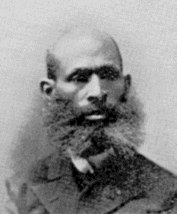The Underground Railroad in the Capital District
From The Freedom Seeker, Vol I, Issue I, Winter 2003-2004
By Paul Stewart, URHPCR President

Stephen Myers, leader of Underground Railroad in Albany (1830s-50s) (courtesy of Albany Public Library, Picture from Autobiography of William Henry Johnson, 1900)
Albany was a busy port city throughout the nineteenth century. During its most active Underground Railroad days, the city was occupied by lumber and other businesses at the riverfront and numerous retail establishments along Market Street (our current Broadway), Pearl Street, and corresponding cross streets. Although it was the state capital (since 1797) Albany truly began to expand only after the completion in 1825 of the Erie Canal, which enhanced the city as a destination for riverboat shipping and traffic.
Commerce along the Hudson and Erie Canal system, and new forms of transportation such as the steamboat and the railroad, greatly increased the opportunities for people, including fugitives from slavery, to travel from port to port, and city to city. The new transportation systems, as well as burgeoning social movements of the antebellum period, such as Sunday School, temperance and women’s rights movements, provided abundant opportunities for the sort of networking that facilitated Underground Railroad efforts.
And the Underground Railroad was just that: a network of people providing assistance to fugitives from slavery in the early and mid 19th century prior to the Civil War (1861.1865). These fugitives were assisted by free blacks, whites, church people, political abolitionists, men and women, and they traveled to freedom by any means available. When traveling through New York State to Canada, fugitives often passed through Albany to Buffalo (and then on to Canada), while others chose an eastern route into Vermont and along the Champlain Canal.

William Henry Johnson, local abolitionist Educator and Administrator and UGRR activist. Picture courtesy Albany Public Library from Autobiography of William Henry Johnson, 1900
Supporters of slavery, meanwhile, regarded it as a moral and economic necessity to maintain the slave economy. Opposition to this brutal system of human bondage took many forms: some people worked within the political system, some people took up arms, some people chose writing, others chose civil disobedience through assisting fugitives. Even though slavery was abolished in New York State in 1827, the Federal Fugitive Slave Laws of 1793 and 1850 continued slavery’s legal presence in the free states of the north, obliging those states to honor the rights of southern plantation masters to own people as “chattel” property.
Over the 30 years prior to the Civil War many people in the Capital Region chose to disobey federal statutes by assisting fugitives from slavery. Those who aided “freedom seekers” included journalist Stephen Myers, local leader of the movement, who over two decades helped thousands pass through the region in their escape from slavery, William Henry Johnson, a tireless abolitionist who moved to the area in 1851, and the Mott sisters, Abigail and Lydia, members of the local Quaker community.
Few, if any, buildings used by abolitionists and freedom seekers exist in Albany due to fires and urban development, so it is difficult to visualize their activities in the The Freedom Seeker is a publication of the Underground Railroad History Project of the Capital Region, Inc., a non-profit built environment of our city. Telling their stories and preserving their presence in corporation dedicated to promoting and encouraging knowledge and understanding of the 19th-century Underground Railroad our historical landscape is the mission of the Underground Railroad History Project Movement in the Capital Region, in New York State, and in the United States. This newsletter is published three times a year. of the Capital Region, a non-profit educational organization dedicated to preserving the historical record of the UGRR in our city and our region.

